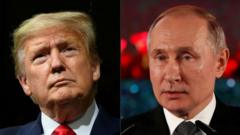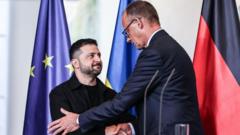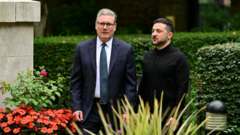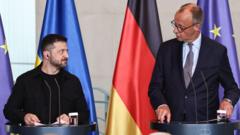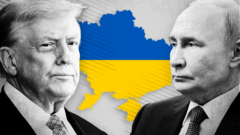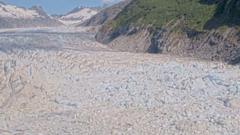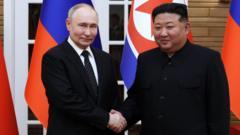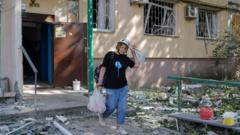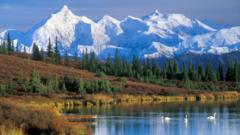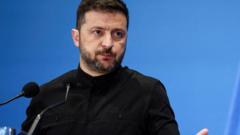**As they prepare for the summit, Trump seeks to position himself as a peacemaker, while Putin aims for American recognition of Russia's territorial ambitions.**
### Diverging Goals: What Trump and Putin Hope to Achieve at the Alaska Summit
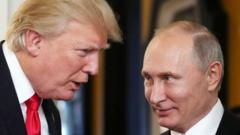
### Diverging Goals: What Trump and Putin Hope to Achieve at the Alaska Summit
**U.S. President Donald Trump and Russian President Vladimir Putin's upcoming meeting in Alaska is marked by their differing priorities surrounding the Ukraine conflict.**
In a politically charged meeting set to unfold in Anchorage, U.S. President Donald Trump and Russian President Vladimir Putin's agendas starkly contrast regarding the ongoing war in Ukraine. As the leaders prepare for their summit, Putin's longstanding desire for territorial gains in Ukraine stands in sharp relief against Trump's bid to reclaim his status as a global peace broker.
For Putin, a significant objective on his part is gaining international recognition for Russia's actions in Ukraine. This summit, the first high-level encounter since the escalation of the war, presents a chance for the Kremlin to showcase its purported return to the forefront of global politics. The meeting's location in Alaska—just a stone's throw away from Russian territory—offers a strategic advantage by minimizing the need to navigate over nations perceived as hostile.
Moscow views the summit in the context of history, as Alaska's sale by Tsarist Russia to the United States exemplifies shifts in territorial claims. The Kremlin leverages this historical episode to justify its current tactics in Ukraine, arguing that borders can be altered by force. However, the stakes are high; while Putin demands to retain control over the territories Russia currently occupies, Ukraine maintains a firm stance against any concessions, declaring it will not surrender land to an aggressor.
Echoing this complex geopolitical dynamic, Trump has fluctuated in his approach towards Ukraine, notably asserting during his 2024 campaign that he could swiftly resolve the conflict. He has oscillated between expressing frustrations towards both Ukrainian and Russian leadership but aims to capitalize on this summit as an opportunity to manifest progress in peace negotiations. Trump’s recent focus on “land-swapping” discussions has raised concerns among Ukrainian officials fearing potential territorial compromises.
Ahead of the summit, Trump has tried to temper expectations, branding the meeting a "feel-out" session to gauge Putin's willingness to discuss peace effectively. He has indicated that he could leave the talks without agreement, but ultimately, he seeks the legacy of a peacemaker and the global accolade that stems from it, including aspirations towards the Nobel Peace Prize.
As the summit draws near, European leaders have rallied to ensure that Ukraine's interests are safeguarded amid Trump’s eagerness to broker peace. While there remains uncertainty about the outcomes, it is evident that both leaders have their own ambitions—Trump, looking for a path to peace that aligns with his image, and Putin, intent on reinforcing Russia’s position on the world stage, regardless of what compromise may require.
For Putin, a significant objective on his part is gaining international recognition for Russia's actions in Ukraine. This summit, the first high-level encounter since the escalation of the war, presents a chance for the Kremlin to showcase its purported return to the forefront of global politics. The meeting's location in Alaska—just a stone's throw away from Russian territory—offers a strategic advantage by minimizing the need to navigate over nations perceived as hostile.
Moscow views the summit in the context of history, as Alaska's sale by Tsarist Russia to the United States exemplifies shifts in territorial claims. The Kremlin leverages this historical episode to justify its current tactics in Ukraine, arguing that borders can be altered by force. However, the stakes are high; while Putin demands to retain control over the territories Russia currently occupies, Ukraine maintains a firm stance against any concessions, declaring it will not surrender land to an aggressor.
Echoing this complex geopolitical dynamic, Trump has fluctuated in his approach towards Ukraine, notably asserting during his 2024 campaign that he could swiftly resolve the conflict. He has oscillated between expressing frustrations towards both Ukrainian and Russian leadership but aims to capitalize on this summit as an opportunity to manifest progress in peace negotiations. Trump’s recent focus on “land-swapping” discussions has raised concerns among Ukrainian officials fearing potential territorial compromises.
Ahead of the summit, Trump has tried to temper expectations, branding the meeting a "feel-out" session to gauge Putin's willingness to discuss peace effectively. He has indicated that he could leave the talks without agreement, but ultimately, he seeks the legacy of a peacemaker and the global accolade that stems from it, including aspirations towards the Nobel Peace Prize.
As the summit draws near, European leaders have rallied to ensure that Ukraine's interests are safeguarded amid Trump’s eagerness to broker peace. While there remains uncertainty about the outcomes, it is evident that both leaders have their own ambitions—Trump, looking for a path to peace that aligns with his image, and Putin, intent on reinforcing Russia’s position on the world stage, regardless of what compromise may require.


